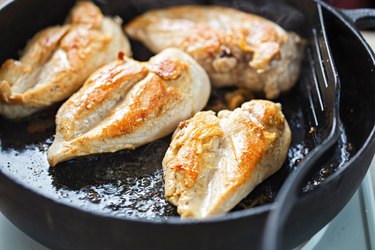
You bought that beautiful steak and spent time prepping and cooking it. Once it's finally plated, you take a bite only to discover it's completely dry and bland. Sound familiar?
Many of us have struggled with cooking meat at some point or another. Beef, pork and poultry obviously taste more delicious when they're moist and tender — and there are a few measures we can take to guarantee that end result.
Video of the Day
Video of the Day
Here are some of the most common mistakes people make when cooking meat and how to fix them.
1. You Don't Pound It Out
If you throw a chicken cutlet or steak on the grill (or in your broiler) without using your meat pounder first, brace yourself for some lackluster meat. While many of us are guilty of being lazy with this step, adding it to our prep routine will be well worth it.
Fix It: Using a meat mallet with a jagged edge to pound on steak, pork or poultry is a great way to break down muscle fibers that may keep meat tough. Pound down something like chicken breast, cube steak or chuck steak to approximately a quarter-inch-thick before cooking.
No meat mallet? Try something else in its place. A rolling pin, cast iron skillet or heavy saucepan all will work well. If you're still desperate for a mallet, a regular hammer can be used also, just be sure to clean it well beforehand!
Meat Mallets to Buy
2. You Don't Cut Against the Grain
Cutting across the grain simply means slicing perpendicular to the direction of the fibers, which makes the meat more tender and easier to chew. And skipping this step, just like neglecting to pound the meat, can also result in a chewy cut that's far from tender.
Fix It: Look for the long muscle fibers and cut across them rather than parallel with them. When slicing less-tender cuts across the grain, slice thinly to further assist with tenderness, recommends Bridget Wasser, the meat science, culinary and supply chain executive director for the National Cattlemen's Beef Association.
Not sure if you see the muscle fibers or which direction the grain is going? Look for bundles of fibers that are grouped together and run in a single direction, or together in a parallel fashion, down the meat. They usually look like long white lines within the meat. Once you find these parallel fibers, cut across them to slice and serve.
3. You Forget to Marinate
Certain cuts of meat, including flank and skirt steak or chicken breast, can be tough but marinating helps break down those tough proteins and muscle fibers before they hit the grill or skillet. And you can easily avoid forgetting this crucial step by meal planning ahead of time.
Fix It: Marinating beef, poultry and pork tenderizes the meat and infuses flavor. Marinades should include acidic ingredients, such as vinegar, citrus juice or yogurt, or natural enzymes, such as pineapple or ginger. These ingredients help break down the muscle fibers in the meat before it's cooked.
Aim for marinating the meat anywhere between one hour and overnight, and always remember to store the meat in the refrigerator — never at room temperature — while it's marinating to prevent foodborne bacteria.
Marinade Recipes to Try
4. You Cook the Cut the Wrong Way
Sure, prepping your meat the right way before tossing it on the grill, in your oven or on a cast iron can make all the difference, but your cooking method also counts. Different cuts of meat should be cooked differently and these factors include how you decide to cook it and the temperature you use.
Fix It: More tender steaks like strip, ribeye, tenderloin and T-bone steaks can be cooked with dry-heat cooking methods like grilling and broiling but roasts and less tender steaks like flank, skirt, round and chuck steaks should be cooked using moist-heat cooking methods like braising or slow-cooking to elevate tenderness, Wasser says.
Dry-heat cooking tends to be quick-cooking while moist-heat methods are more low-and-slow. Cuts that come from active areas, such as the shoulder or chest, contain more muscle fibers and need time and heat to break down the connective tissue.
Temperature plays a role as well and is the best indicator of doneness, Wasser says. Overcooking or undercooking beef, poultry or pork can make it chewy. It's always a good idea to use a meat thermometer to be sure, and follow the U.S. Department of Health & Human Services' guidelines below. Remember that the internal temperature of meat continues to rise for a few minutes after cooking.
Safe Minimum Cooking Internal Temperatures for Meat
- Ground beef, pork, veal and lamb: 160 degrees Fahrenheit
- Ground turkey and chicken: 165 degrees Fahrenheit
- Fresh beef, veal, lamb, pork and ham: 145 degrees Fahrenheit
- Poultry: 165 degrees Fahrenheit
Tip
Always let meat rest after cooking and before slicing. Wasser says that this prevents flavorful juices from draining onto your plate or cutting board, which can result in dry, tough meat. The juice needs time to redistribute in that grilled steak, roast chicken or pork loin.
Was this article helpful?
150 Characters Max
0/150
Thank you for sharing!
Thank you for your feedback!